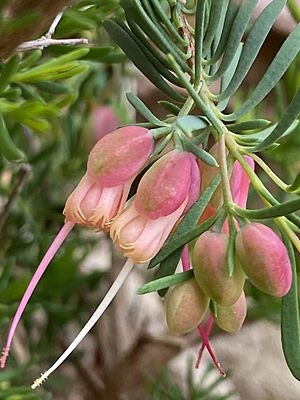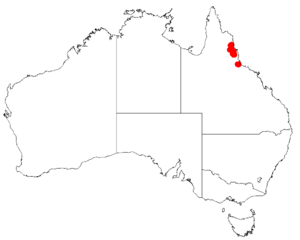Homoranthus porteri facts for kids
Quick facts for kids Homoranthus porteri |
|
|---|---|
 |
|
| Conservation status | |
| Scientific classification | |
| Genus: |
Homoranthus
|
| Species: |
porteri
|
 |
|
| Occurrence data from AVH | |
| Synonyms | |
|
|
Homoranthus porteri is a unique plant that belongs to the myrtle family. It grows only in a small part of northern Queensland, Australia. This plant is a shrub that stands upright and has pretty creamy-white to red flowers that hang down. These flowers grow in pairs on short stems and have red leaf-like parts called bracts. The plant also has small, thin leaves.
What Does It Look Like?
Homoranthus porteri is a shrub that can grow up to about 2.5 meters (which is about 8 feet) tall. Its leaves are a dull green color and are quite small, around 12 millimeters (less than half an inch) long and 1.5 millimeters wide. The leaves are arranged in a cool spiral pattern, with each pair of leaves growing at a right angle to the pair before it on the branches.
The small flowers hang down in pairs from where the leaves meet the stem. These flowers have bright red bracts and a long, thin part called a style that sticks out from the center of the petals. This style is about 1.5 centimeters (a bit more than half an inch) long. The plant usually flowers in autumn, but you might see flowers and fruits at other times of the year too.
How It Got Its Name
This plant was first officially described in 1931 by a scientist named C.T. White. He first called it Darwinia porteri. Later, in 1991, two other scientists, Lyndley Craven and S.R. Jones, changed its name to Homoranthus porteri.
The second part of its scientific name, porteri, was chosen to honor Charles Porter. He was the person who first collected a sample of this plant, which scientists call the "type specimen."
Where Does It Grow?
Homoranthus porteri is found only in a specific area of Queensland, Australia. You can find it between the towns of Mareeba and Ravenshoe. It usually grows near woodlands, on rocky slopes, or in heath areas. It prefers shallow, sandy soils and often grows on rock outcrops.
Why Is It Special?
Homoranthus porteri is considered a "vulnerable" species by the Australian Government. This means there aren't many of these plants left, and they are at risk of disappearing if we don't protect them. It's important to protect plants like Homoranthus porteri because every species plays a role in our planet's ecosystems.


